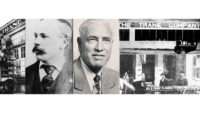It’s a wonderful life
The Paul System has quite a story to tell.


|
So I walk into this loft apartment on Fifth Ave. in lower Manhattan and the first thing I see are three enormous video monitors spread across a semicircular desk. They’re attached to a film-editing system that would make Francis Ford Coppola smile, but instead the owner of that system smiles and says hello.
I’m with a bunch of people from the building, along with my friends, Valerie and Allen, who are there to make recommendations on how to save fuel in this 1905, voraciously steam-heated building, which is home to both residential and business tenants. It is a place of regal beauty. People who can afford to live in such buildings know how to decorate and I was poking around. I really like to poke around.
Editing system aside, the first thing I really noticed when I entered that loft apartment was the radiator under that window over there. It came nearly up to my waist and stared at me in that heavy, ornate Victorian way. It must have weighed at least 700 lb., and two of its iron feet had managed to claw their way down an inch into the wood floor during the past century. This was causing the water to lie inside the radiator at a point lower than the radiator’s outlet pipe, and that was leading to the water hammer that was making the condensate squirt skyward. Somewhere during the long history of this heating system, someone had removed the Paul-line air vent and replaced it with an ordinary air vent, which wasn’t at all happy.
I started to explain all this to the group when that antique machine over there grabbed my attention and shook me by the shoulders. “Forget the radiator,” it shouted. “Look at me!” So I did.
The film editor smiled and said, “That was Frank Capra’s machine.”
“Really? Frank Capra? As in “It’s a Wonderful Life” Frank Capra. Jimmy Stewart and Donna Reed and Clarence the Angel? That Frank Capra?”
“Yes.”
This got me thinking about what a wonderful business this is where we often get to poke into the lives of people we’ve never met before and all because they happen to have misbehaving radiators in their homes. You never know what you’ll run across when you’re the heating guy.
History lesson
Which brings me to Andrew Greenleaf Paul, who died March 6, 1920 in his Boston home. He was 71 years old. Chances are you’ve never heard of him, but he once was the general sales manager of Fairbanks Co. He originated the design of the Fairbanks valve. You’ve probably heard of that.
Andrew Paul was sitting in his office one day, looking up at the steam coil in this skylight that was giving them all fits. The coil kept binding up with air, which kept the steam from entering. Where there is air, steam will not go, and that’s why we use steam air vents. Since this coil was air-bound, ice was forming on the inside of the skylight and water was dripping on the folks below. Not good.
One day, Andrew Paul noticed to his delight that the coil was now working. He spotted a small, brand-new pipe that connected to the outlet of the coil. His friend and coworker, Bill Skiffington, looked over and smiled. Bill had added that pipe, hooking it up to a small vacuum pump to get rid of the air that was blocking the steam. “Great Scott, man,” Andrew Paul said. “Do you realize what this means? You must get this patented at once!”
This was in 1891 and Bill Skiffington took Andrew Paul’s advice. He applied for the patent right away, assigning a three-quarter interest to Mr. Paul, who most likely had the money available to make things happen.
And things did happen, although slowly at first. Andrew Paul organized the New England Engineering Co. in Boston and set out to develop the science of vacuum steam heating. If you ever run across a vacuum pump on a steam system in a big building and it has you wondering, think of this guy. He started something huge in heating history.
But there was little progress at first, even though some money was coming in from royalties. Andrew Paul decided to charge contractors two cents per sq.-ft. of radiation to use the system, and in a big building that can add up. After a while, he reorganized as the Paul Steam System Co., and later a Chicago company formed as the Western Paul Steam System Co. They also paid him royalties.
And the rest is history
In 1900, Albert A. Cryer and Associates set up the Paul System Co. of New York and went to town installing the Paul System in lots of big buildings throughout lower Manhattan. By using a patented system of ejectors, they produced a vacuum that sucked the air from the pipes, allowing the steam to rocket from the boiler to the radiators. Old ads claim this system could cut the fuel bill by 30% and that had building owners lining up to get it.
Albert A. Cryer and Associates got to the building I was visiting in 1905. Andrew Paul stayed at his company in Boston, preferring to sit pretty and collect royalties, which were now up to 12 cents per sq.-ft. of installed radiation. Over the next 10 years, the royalties alone brought Andrew Paul what would today be equivalent to about $11 million. Nevertheless, he managed to die a poor man, leaving a wife and one son. I don’t know how that happened but it was a wonderful run.
“What’s with the third pipe?” one of the members of our group asked me.
“That’s the vent line coming down from all the Paul air vents on the radiators,” I said.
“Why is it hot? Most of those lines are abandoned. There are regular air vents on the radiators now”
“But not on all of them,” I said. “And I know none of the original Paul vents are working, not after all these years. Steam is passing from one failed vent into that third pipe that’s connecting to the other failed vents. You’ll need to disconnect all of them.”
“So air vents go on all the radiators?”
“Yes, at this point. This is a two-pipe, air-vent system. They didn’t use steam traps in 1905 because those were just being invented. When they had big radiators such as these, they fed steam into one side through a radiator supply valve and drained condensate from the opposite side through a radiator return valve, which is identical to the supply valve but just on the other side.”
I pointed to all this and as we went from interesting loft space to fascinating loft space, I showed them how this radiator hookup repeated itself throughout the building.
“Notice how the supply riser is one size larger than the return riser? That’s how you know it’s a two-pipe, air-vent system. The systems that came later, the ones with the steam traps, had much smaller returns. Those later systems weren’t designed to have steam in the return lines. This one is supposed to have steam in the return lines.
And I was telling them this at just the right time because we had come to an apartment where someone had installed steam traps on the return side of the radiators.
“These make lots of noise,” one of guys said.
“The traps are causing that. You can’t have traps on this system. When they close, the steam just shrugs and uses the other pipe. That causes water hammer as the trap makes the condensate backup inside the radiator.”
We went to the basement and marveled at the way the Dead Men used a loop-seal arrangement at the bottom of each riser to trap the steam. They didn’t use F&T traps because loop seals were simpler and less expensive. They also don’t break.
Finally, I noticed someone had connected the thermister for the Heat-Timer control onto a pipe that would always be filled with water. Whoever had done this had missed the subtlety of the loop seals that were in other rooms. The Heat-Timer had no way of knowing when to stop the boiler because the thermister was never going to reach steam temperature on that condensate-return line. Move that thermister and the fuel bills will probably plummet.
We also talked about adding thermostatic radiator valves between the air vents and the radiators in the rooms that were overheating, and I made a few other suggestions before we wandered in and out of some more apartments. I really didn’t need to do that, but I do love to see what those rich folks spend their money on. And besides, I’m the heating guy. I get to go anywhere there’s a radiator.
It’s a wonderful life.
HELPFUL LINKS:
Looking for a reprint of this article?
From high-res PDFs to custom plaques, order your copy today!







